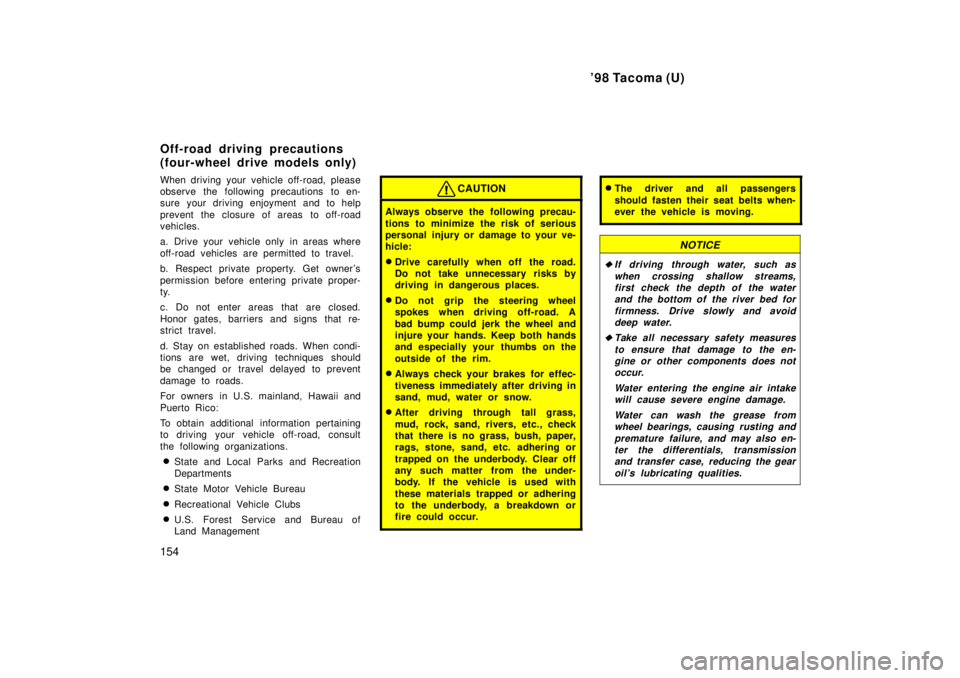transfer case TOYOTA TACOMA 1998 Owners Manual
[x] Cancel search | Manufacturer: TOYOTA, Model Year: 1998, Model line: TACOMA, Model: TOYOTA TACOMA 1998Pages: 246, PDF Size: 4.33 MB
Page 96 of 246

'98 Tacoma (U)
96
To shift from ºH4º to ºH2º,
push the
º4WDº button again to turn it off.
This can be done at any vehicle speed.
If the indicator light does not go off when
you shift the transfer into `'H2º, drive
straight ahead while accelerating or decel-
erating, or drive in reverse. SHIFTING BETWEEN ºH2º OR ºH4º AND
ºL4º
To shift from ºH2º or `'H4º to ºL4º,
stop the vehicle and put the transmission
in ºNº. With your foot holding down the
brake pedal, move the front drive control
lever.
To shift from ºL4º to ºH2º or ºH4º,
stop the vehicle and put the transmission
in ºNº. With your foot holding down the
brake pedal, move the front drive control
lever. When the º4WDº button is pushed
in, the transfer shifts into ºH4º; when the
button is left out, the transfer shifts into
ºH2º.
If the indicator light does not go off when
you shift the transfer into ºH2º, drive
straight ahead while accelerating or decel-
erating, or drive in reverse. Rear differential lock system
The rear differential lock system is pro-
vided for use only when wheel spinning
occurs in a ditch or on a slippery or
ragged surface.
This differential lock system is effective in
case one of the rear wheels is spinning.
Except for Pre Runner models
'
Before using the rear differential lock sys-
tem, first shift the front drive control into
ºL4º with the free-wheeling hubs engaged
to see if it works. If this has no effect,
additionally use the rear differential lock
system.
Page 154 of 246

'98 Tacoma (U)
154
When driving your vehicle off-road, please
observe the following precautions to en-
sure your driving enjoyment and to help
prevent the closure of areas to off-road
vehicles.
a. Drive your vehicle only in areas where
off-road vehicles are permitted to travel.
b. Respect private property. Get owner 's
permission before entering private proper-
ty.
c. Do not enter areas that are closed.
Honor gates, barriers and signs that re-
strict travel.
d. Stay on established roads. When condi-
tions are wet, driving techniques should
be changed or travel delayed to prevent
damage to roads.
For owners in U.S. mainland, Hawaii and
Puerto Rico:
To obtain additional information pertaining
to driving your vehicle off-road, consult
the following organizations.
� State and Local Parks and Recreation
Departments
� State Motor Vehicle Bureau
� Recreational Vehicle Clubs
� U.S. Forest Service and Bureau of
Land Management
CAUTION
Always observe the following precau-
tions to minimize the risk of serious
personal injury or damage to your ve-
hicle: �Drive carefully when off the road.
Do not take unnecessary risks by
driving in dangerous places.
� Do not grip the steering wheel
spokes when driving off-road. A
bad bump could jerk the wheel and
injure your hands. Keep both hands
and especially your thumbs on the
outside of the rim.
� Always check your brakes for effec-
tiveness immediately after driving in
sand, mud, water or snow.
� After driving through tall grass,
mud, rock, sand, rivers, etc., check
that there is no grass, bush, paper,
rags, stone, sand, etc. adhering or
trapped on the underbody. Clear off
any such matter from the under-
body. If the vehicle is used with
these materials trapped or adhering
to the underbody, a breakdown or
fire could occur.
�The driver and all passengers
should fasten their seat belts when-
ever the vehicle is moving.
NOTICE
�If driving through water, such as
when crossing shallow streams,first check the depth of the waterand the bottom of the river bed for
firmness. Drive slowly and avoiddeep water.
�Take all necessary safety measures
to ensure that damage to the en-gine or other components does notoccur.
Water entering the engine air intakewill cause severe engine damage.
Water can wash the grease fromwheel bearings, causing rusting and
premature failure, and may also en-ter the differentials, transmission and transfer case, reducing the gear
oil's lubricating qualities.
Off-road driving pr ecautions
(four-wheel drive models only)